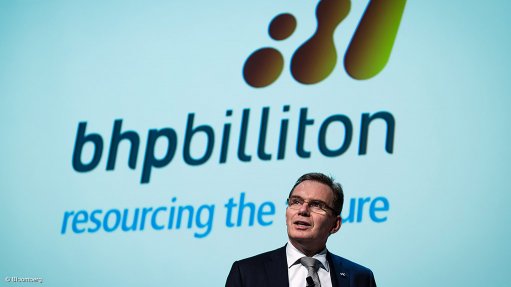
BHP Billiton CEO Andrew Mackenzie
Photo by: Bloomberg
PERTH (miningweekly.com) – Mining major BHP Billiton on Wednesday announced plans to defer its inner harbor debottlenecking project, in the Pilbara, as its iron-ore operations delivered record production during the nine months ended March.
Production from the iron-ore operations was expected to reach 250-million tonnes this year, with BHP saying that the company’s installed infrastructure had continued to exceed expectations. Further growth in supply chain capacity to 270-million tonnes a year was expected to be achieved without the need for additional fixed plant investment.
As a result, the inner harbor debottlenecking project, which would increase capacity to 290-million tonnes a year, was being deferred.
BHP noted that while the deferral of this project would lead to a slower path to the 290-million-tonne-a-year capacity, it would come at a lower capital cost.
“In iron-ore, our focus remains on producing at the lowest possible cost, with Western Australian iron-ore unit costs now below $20/t, as we continue to improve productivity,” said BHP CEO Andrew Mackenzie.
“Over the last decade, China’s unprecedented demand growth provided Australia and BHP Billiton with a unique opportunity. We acted swiftly to bring on new iron-ore capacity at some of the lowest costs globally, generating long-term value for shareholders, the government and communities which would otherwise have been lost to overseas competitors.”
Mackenzie noted that despite the subsequent increase in supply-side competition, these low-cost expansions continued to deliver attractive margins and returns through the cycle.
Iron-ore production during the quarter ended March reached 58.9-million tonnes, up 20% on the previous corresponding period, and up 5% on the previous quarter. Year-to-date production for the nine months ending March was up by 17% on the previous period, to 172.4-million tonnes.
Meanwhile, petroleum production during the quarter was also up by 1% on the previous corresponding period, to 61.5-million barrels of oil equivalent. Total petroleum production for the nine months ended March increased by 6%, to a record 192.5-million barrels of oil equivalent, as onshore US liquid volumes rose by 76%.
“In petroleum, we have responded quickly to current market conditions by reducing the number of rigs operated in our onshore US business by 35% over the March 2015 quarter,” Mackenzie said.
“We continue to review our drilling and development programme as we seek to maximise the value of our resource base. With higher oil prices expected over the medium term, we believe deferring development will create more value than producing today. Our high-quality acreage and excellent operating performance, with industry-leading drilling costs, gives us a strong platform from which to build.”
Meanwhile, copper production increased by 11% during the quarter under review, to 460 000 t, and by 1% in the year-to-date, to 1.2-million tonnes.
Metallurgical coal production remained stagnant during the quarter, at 37.7-million tonnes, while year-to-date production increased by 14%. BHP reported that energy coal production increased by 11% quarter-on-quarter, to 19.7-million tonnes, while year-to-date production increased by 2%, to 56.1-million tonnes.
In total, group production increased by 9% for the nine months ended March 2015 with records achieved for ten operations and five commodities. Mackenzie told shareholders that BHP remained on track to deliver group production growth of 16% over the two years to the end of the 2015 financial year.